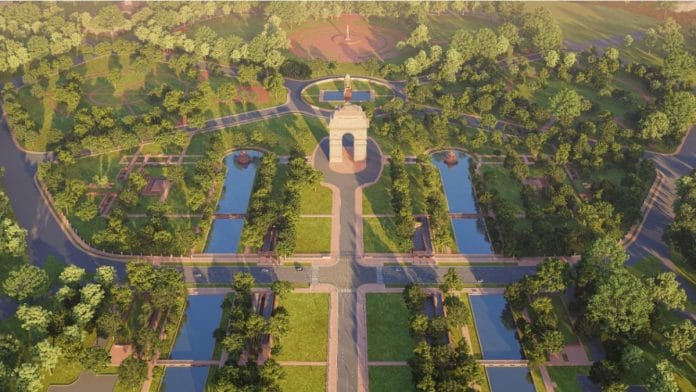New Delhi: Less than a month after he urged the country to remove all vestiges of colonialism from India on Independence Day, Prime Minister Narendra Modi is set to inaugurate the ‘Kartavya Path’ Thursday evening in the heart of the national capital.
The timing and, more importantly, the choice of location is not lost on many as it, according to the PM’s personal website, “symbolises a shift from erstwhile Rajpath being an icon of power to Kartavya Path being an example of public ownership and empowerment”.
The word ‘Kartavya’ (duty) has featured frequently in PM Modi’s speeches. In 2019, while speaking during Pariksha Pe Charcha, Modi had first mentioned how fundamental rights and duties should not be seen in isolation and gave examples of how rights and duties do not conflict.
In January, the PM rekindled the ‘Rights vs Duties’ debate during an Azadi ka Amrit Mahotsav event when he urged everyone to walk on the “path of duty”, stating how forgetting one’s duties completely has played a huge role in keeping India weak.
“In the past 75 years, we only kept talking about rights, fighting for rights and wasting our time. The issue of rights may be right to some extent in certain circumstances, but neglecting one’s duties completely has played a huge role in keeping India vulnerable,” he had said.
The Rajpath, earlier known as Kingsway, was originally designed to be a grand processional pathway to the Viceroy’s House during the British Raj. The 3 km stretch was built by architects Edwin Lutyens and Herbert Baker in around 1920.
The Kartavya Path is part of the newly-developed Central Vista avenue of the Central Vista Redevelopment project, which includes the new Parliament building, Chambers for Members of Parliament and other government buildings.
Professor Chandrachur Singh, a political analyst, calls it an effort to reimagine a new India and remove the signs of a ‘weak past’.
“PM Modi’s own understanding of India, and the kind of things he says about India, is more about a new India which is very robust, which cannot be taken for a ride. Perhaps what he is trying to do is differentiate the past and the future. And distinction between the past and the future is only laid down by constructing something which is very innovative and does not remind the future generations of a weak past or a historical construct,” he says
Constitutional expert Faizan Mustafa says that the narrative of focusing more on ‘duty’ is not a new concept and that PM Modi is not revoking something new.
“Indian culture is duty-focused. It is not rights conscious. Not just PM Modi, but also Gandhiji and many other leaders have emphasised on performing duties. But liberal constitutions did not have this concept. That is why the Indian Constitution, too, did not have this concept. The chapter on fundamental duties was brought in later by Indira Gandhi in 1976,” he says.
It was the Indira Gandhi government that introduced the Fundamental Duties through the 42nd Constitutional Amendment Act, 1976, by inserting Article 51-A into the Constitution. There were originally 10 duties and later another was added by the Atal Bihari Vajpayee government through the 86th Constitutional Amendment Act, 2002.
The constitution of the erstwhile Union of Soviet Socialist Republics (USSR) and the Universal Declaration of Human Rights are said to be the driving force behind these duties meant for Indians.
Also Read: Who gets what, will it measure up — the complexities of colonialism reparations & compensations
Emphasis on ending colonial hangover
Ever since it came to power, the Modi government has been removing signs of the British colonial era. Earlier this year, the traditional Christian hymn ‘Abide by Me’ from the Beating the Retreat ceremony was replaced by the evergreen ‘Ae Mere Watan Ke Logo’.
Last week, the cross of Saint George on the Indian Navy’s flag was replaced by a seal featuring Maratha warrior king Shivaji’s emblem.
In January, the Amar Jawan Jyoti was merged with the flame at the National War Memorial. “The names inscribed on the India Gate are of only some martyrs who fought for the British in World War I and the Anglo-Afghan War and thus are a symbol of our colonial past,” the government had said.
Professor Singh, however, cautions that this kind of “darkening of history” has its own pitfalls.
“This kind of a narrative is very double-sided in the sense that the history of a nation cannot simply be cut out or blackened. At the end of the day, even if it was exploitative, it does have inspirational value,” he says.
On the positive side, the political analyst says, these are attempts to suggest that the country has come out of the dark ages and perhaps the new age belongs to a very modern India. “Naturally, this is basically designed to come out of the shadows of the past.”
“However, it is flawed as at one one hand, it gives us the understanding of an India that will be tomorrow. But ‘tomorrow’ becomes much more meaningful if we see it in the context of ‘yesterday’,” Singh asserts.
Completely rewriting, or re-emphasising the value of the future by darkening the past has its own problems, he adds.
(Edited by Tony Rai)
Also Read: India needs to challenge colonialism in its own language. But solution isn’t Hindu worldview






